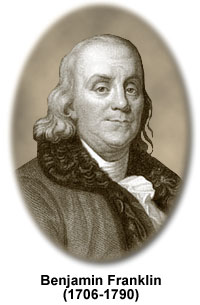Benjamin Franklin
(1706-1790)

Benjamin Franklin was born to a poor soap boiler on January 17, 1706 in Boston, Massachusetts. He was one of many children in his family, and he learned to appreciate the rewards of hard work at age twelve as an apprentice at his brother James' printing shop. By the age of seventeen, Franklin's skills as a printer had become so strong that at twenty-two he left Boston to open his own printing shop in Pennsylvania. This is where he developed his two most famous publications, The Pennsylvania Gazette, the most popular newspaper in the colonies, and the annual Poor Richard's Almanac. Franklin was one of the first printers to use cartoons in his publications in order to accommodate the people who had not learned to read. He believed that his publications were a way to get information to every person, not just those who could read.
In Pennsylvania, Franklin founded organizations, became involved in the community, and assembled a vast collection of inventions that would allow people to live better lives. He started the first circulatory library known as the American Philosophical Society and founded an academy that would soon become the University of Pennsylvania. As a journalist, Franklin was constantly putting on and taking off his reading glasses. He became frustrated with the repetition of this task, so he cut the bottom half of his reading classes and put them in the frames of another pair of spectacles. He had given birth to the bifocals, which many of us still use today.
His scientific mind was always looking for ways to make life easier. This led him to invent the lightning rod, the Franklin stove, the odometer, and a variety of devices like the wooden "long arm." He also created the first fire company and the first fire insurance company in order to help people live safer lives. In 1748, Franklin retired from printing in order to focus his attention on electricity.
Franklin developed many electrical theories and often found innovative, and sometimes quite dangerous, ways to test them. One of his most well known theories was that lightning is a form of electricity. Discovering evidence to support this notion at first seemed to be a very difficult endeavor to achieve. How was he going to actually access lightning, a phenomenon that had mystified humans for thousands of years? Franklinís letters indicate that he initially planned a scheme that would involve a spire that was being built on a church in Philadelphia. He soon decided, however, that the spire would not be nearly tall enough to provide him adequate access to the clouds where lightning forms during a storm. A kite, he realized, could be flown to great heights, leading to the famous kite and key experiment.
Reportedly in June of 1752, Franklin and his son (who was twenty-one at the time, rather than a young boy as often appears in illustrations of the famous experiment) ventured into an open field as a thunderstorm approached. There they sent up a kite Franklin had constructed from silk. Because he knew that metal was a conductor of electricity, Franklin attached a metal rod to the top of the kite and a large metal key near the bottom of the string by which he held the kite. He thought that if lightning really were electricity, then it would charge the metal rod and would travel down the string to the key, electrifying it as well. The experiment worked exactly as he hoped. After flying the kite in the thunderclouds for some time, he noticed that the key gave off sparks when he touched it, a clear sign that it was electrified.
An educated Franklin brought his intellectual ideas and superior communication skills to the politics of a forming nation. In 1757, Franklin was sent to England as a representative of the colonies in the quarrel between England and the Colonies, and he returned as an advocate of independence. He served as a member of the Continental Congress where he helped Thomas Jefferson draft the Declaration of Independence in 1776. Franklin then became the ambassador to France, where he persuaded the French to aid the Americans in the Revolutionary War. He continued to serve the young nation in assisting the creation of the compromises developed at the Constitutional Convention in Philadelphia.
As a journalist, scientist, inventor, statesmen, philosopher, musician, and economist, Benjamin Franklin can be thought of as a colonial Renaissance man. Through hard work and great ideas, Franklin helped shaped a young nation with the aid of his many hard-earned skills. Benjamin Franklin was a pivotal player in the foundation of the United States of America.
